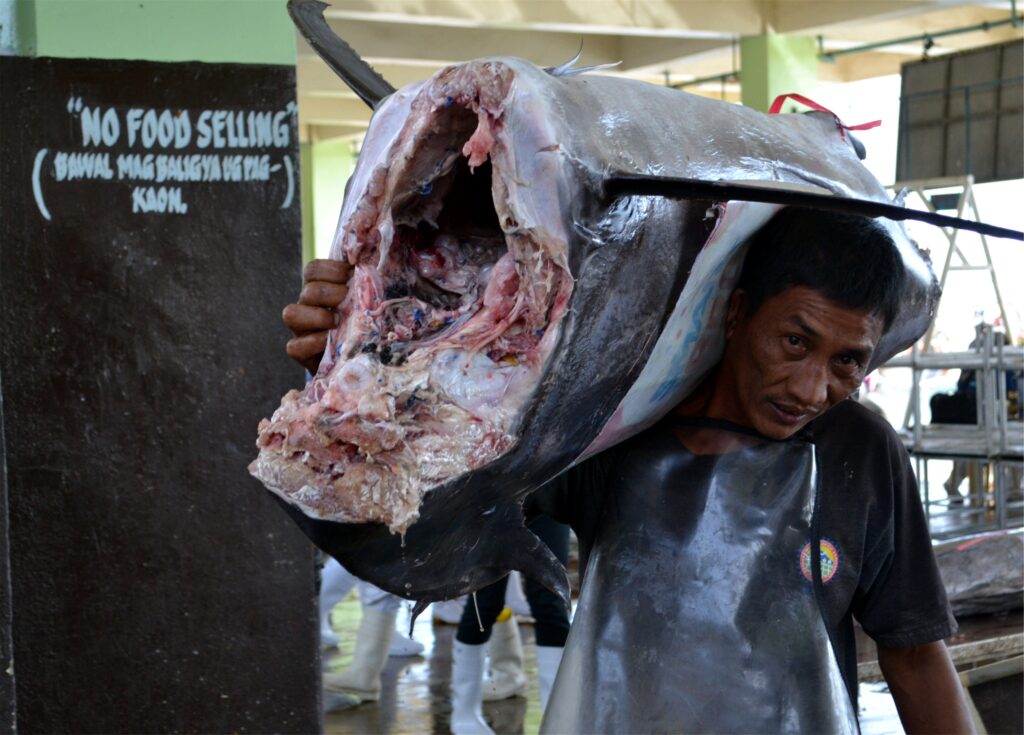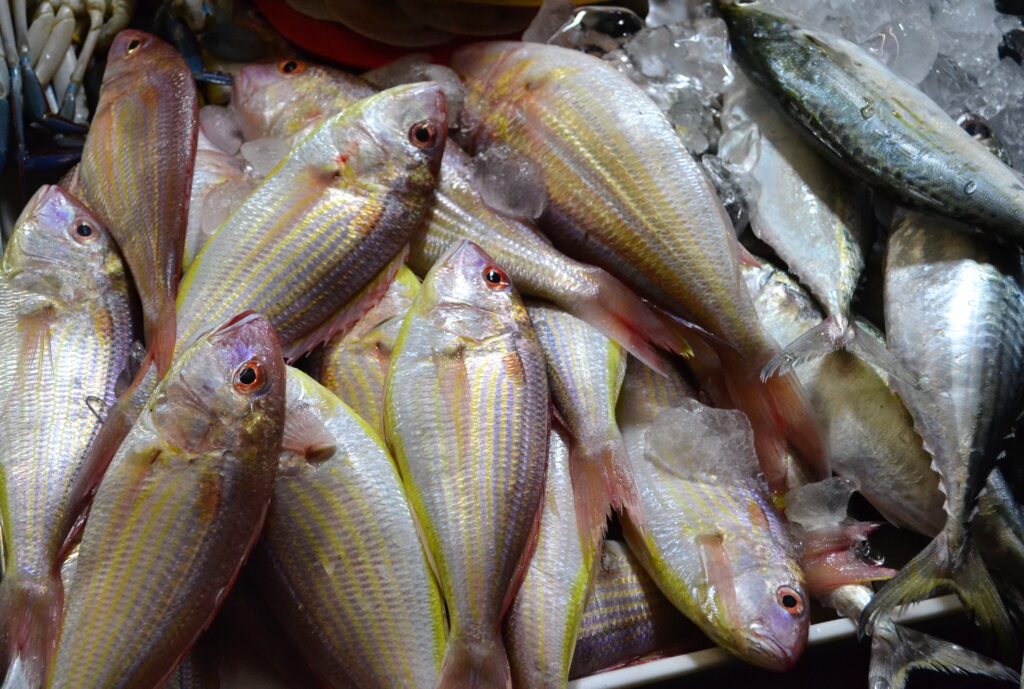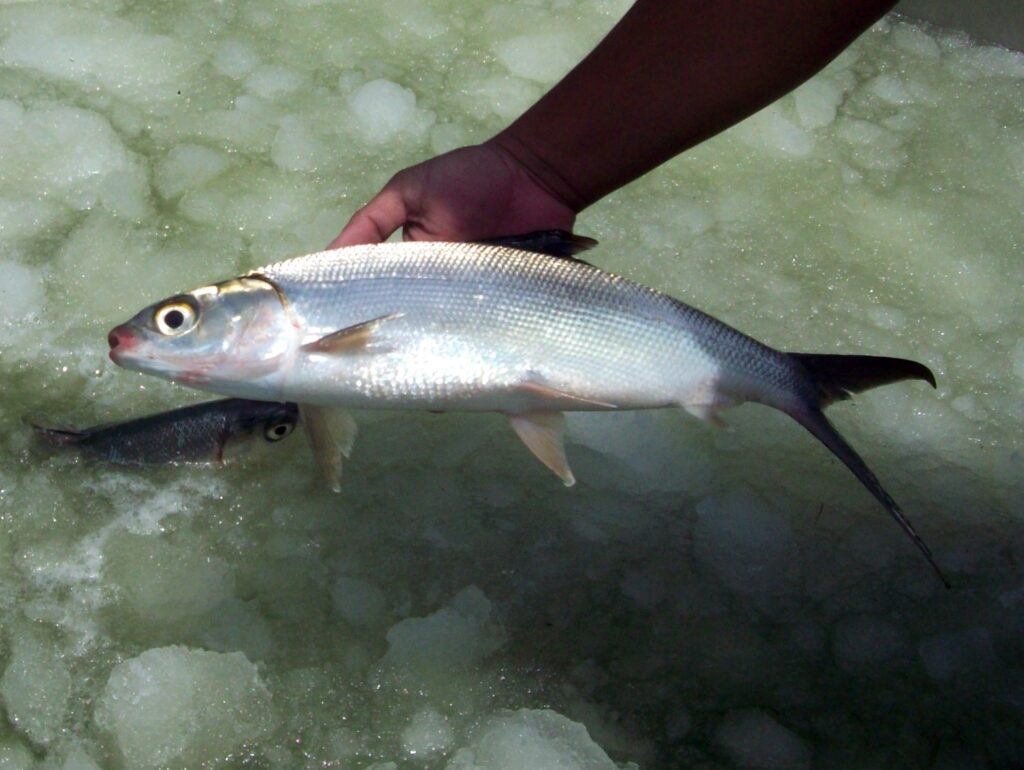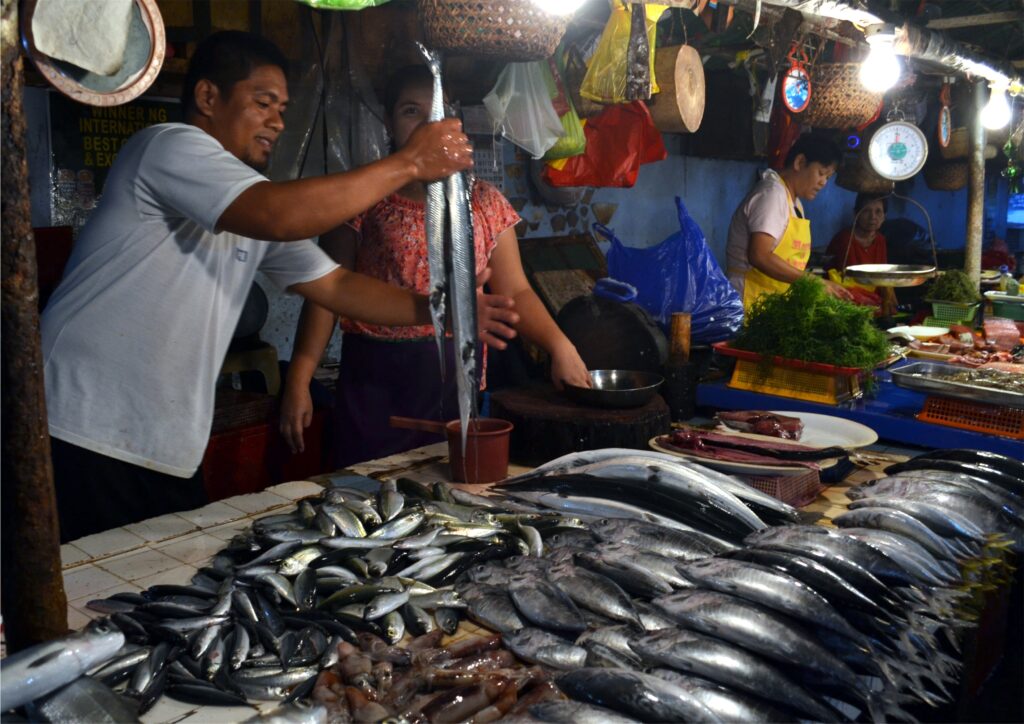Where have all our fish gone?
Written by Henrylito D. Tacio
Jeannyline T. Arriaga, from Bansalan, Davao del Sur, is a doting mother. She usually wakes up early in the morning to prepare breakfast for her two children, who are going to school. Generally, she cooks rice and fish.
Lately, however, she observes that the fish she usually buys at the public market has become scarcer. In fact, there are days when she could not find any that she buys another kind of fish. Her children complain because they don’t like the new fish she serves to them.
Jeannyline also notices that if the fish she likes is available, they are becoming smaller. “They are not only getting scarcer but they are becoming expensive, too,” she points out.

She may not be aware of it but it is not the only fish she likes that is becoming rarer and pricey but the same is true with other varieties of fish. The reason: there are too few fish available now in the open seas.
This has been going on since the late 1990s. In fact, 11 of the world’s 15 major fishing grounds were “seriously depleted,” according to the United Nations Food and Agriculture Organization (FAO).
The Philippines is not spared from such problem. Fish production has dipped spirally in recent years. Last year, for instance, the total volume of fisheries production went down by 1.04% compared to the previous year’s level, the Philippine Statistics Authority reports.
Atty. Gloria Estenzo Ramos, vice-president of Oceana Philippines – an organization working exclusively to protect and restore the world’s oceans – says the fish in the market has become more expensive due to the downtrend in fish catch and their size has become smaller as fish populations become less productive due to overfishing.
A survey by the Social Weather Stations commissioned by Oceana in 2017 found that 82% of Filipinos believe fish sold in the markets are more expensive now compared to 10 years ago. Meanwhile, 54% of respondents said the size of fish has become smaller and 55% said they found less varieties of fish in local markets compared to a decade ago.
“We are running out of fish and running out of time. For a country known for marine biodiversity, there are very few fish left to catch,” Vince Cinches, Oceans Campaigner for Greenpeace Southeast Asia, told a national publication.
“Like the other vital resources such as forests, Philippine fisheries are about to collapse,” deplored Jethro P. Adang, the new director of Mindanao Baptist Rural Life Center (MBRLC), a non-government organization based in Davao del Sur.
The country claims some 220 million hectares as its territorial waters: 193.4 million hectares of which are part of the oceans and the remaining 26.6 million hectares that belong to what is called as Exclusive Economic Zone (EEZ) or those waters surrounding the country up to 200 nautical miles from the shore.
The Philippines has also the Verde Island Passage – situated halfway in the provinces of Batangas and Mindoro – which has “the highest concentration of marine species in the planet,” according to the Southeast Asian Fisheries Development Center (SEAFDEC). Based on studies, its reefs are home to nearly 60% of the world’s known fishes as well as over 300 species of corals.

Poor Fishermen
But despite such huge areas and distinction, the fishermen and those who rely on the oceans and other bodies of water are still grappling with poverty. In fact, most of them belong to the “poorest of the poor” in the society.
“Poverty in coastal communities, the progressive decline of fish population and catch, the pervasive encroachment of commercial fishing vessels in municipal waters are just some of the issues in fisheries that may not be grabbing the national headlines… but they heavily impact in real ways the national economy, food security, the health of our oceans, employment, and our response to the climate crisis,” deplored Ramos.
Fish is considered the “poor man’s source of protein.” Dr. Veravat Hongskul, former regional fishery officer of the UN Food and Agriculture Organization, said: “Fish protein is generally recognized as a valuable ingredient in a balanced diet. It is of high biological value and contains essential amino acids not normally found in staple food.”
About 56% of Filipinos’ animal protein comes from fish, and 91% of fish caught in-country are consumed domestically, Oceana pointed out in a recent press statement. “Not only is fish a vital food source, it also provides livelihood for millions of Filipinos,” it said.
“The fisheries sector is one of the most important sources of food and livelihood in the country,” said Dr. Reynaldo V. Ebora in his presentation during the 12th Annual Meeting and Scientific Convention of Outstanding Young Scientists. “Fish is the country’s second staple food next to rice.”
“Although its share to the gross domestic product is a mere 2%, the gross value added at constant prices of the industry amounted to P123 billion,” he said. “The Philippines ranked 8th among the top fish producing countries in the word in 2014 with its total production of 4.7 million metric tons or about 2.4% of the total world fisheries production.”

Production Is Decreasing
But the production is waning. Majority of the fishing grounds in the country are overfished. “Overfishing is the main issue, with today’s fishers ranging farther and trying harder to catch more – but there are more fishers and too few fish,” observes Gregg Yan, director for Communications for Ocean Philippines.
Davao Gulf, one of the country’s fishing grounds, is a case in point. In his study, “Assessment of the pelagic fisheries in Davao Gulf,” Jose Villanueva of the Bureau of Fisheries and Aquatic Resources (BFAR) found that 45 to 50 percent of the total fish caught daily by most of the fishermen in the gulf are juvenile – too young, not marketable and, therefore, wasted. “If this will continue, there will come a time that we can no longer catch fish here,” he warned.
Villanueva’s findings confirmed the results of a 10-year study entitled “Strengthening Governance and Sustainability of Small-scale Fisheries Management in the Philippines: An Ecosystem-based Fisheries Management Approach in Davao Region.” It was a collaborative effort of the BFAR, local government units and the Department of Science and Technology (DOST) Region 11.
The volume and quality of the fish in the Davao Gulf have been in constant decline at least since the year 2000, according to the study, which involved at least 265 fishermen and was undertaken with the Kuala Lumpur-based World Fish Center.
The study looked at the volume and quality of the harvests of 10 commonly fished species in the gulf: matambaka, tamban, moro-moro, caraballas, bilong-bilong, lapu-lapu, danggit, molmol, talakitok, and maya-maya.
Except for maya-maya, the harvest numbers for the species have been falling. At the current rate of decline, the caraballas, bilong-bilong, molmol, and danggit may all disappear completely from Davao Gulf within a decade. The matambaka, tamban and moro-moro are more resilient, but even they may disappear within a generation.

Degradation of marine ecosystems
Aside from overfishing, there’s the degradation of the country’s marine ecosystems: mangroves, coral reefs and seagrasses.
Mangroves are very important to marine life, according to fishery expert Dr. Rafael D. Guerrero III. They serve as sanctuaries and feeding grounds for fish that nibble on detritus (fallen and decaying leaves) trapped in the vegetation, and on the bark and leaves of living trees.
“(Mangroves) are important feeding sites for many commercially important fish species (mullet, tilapia, eel, and especially milkfish), shrimps, prawns, mollusks, crabs, and sea cucumbers,” says a World Bank report. “Fry that gather in mangrove areas are very important for aquaculture.”
Over the past century, the islands that make up the Philippines have lost nearly three-quarters of their mangrove forests. Panay Island in the Western Visayas is a classic example. It used to be home to over 12,400 hectares of lush mangrove forests. In 1988, only 300 hectares remained.
Recent studies show that only 6% of the country’s coral reefs are in excellent condition. Seventy percent are in various stages of deterioration. A document from the Cebu-based Coastal Resource Management Project (CRMP) said a good to excellent coral reefs can produce 20 tons or more of fish and other edible products per square kilometer annually.
The destruction of these reefs can greatly reduce fish production, marine scientists said. “Once destroyed, they produce less than four tons per square kilometer per year,” the CRMP disclosed.
Seagrasses, which covers an area of 27,282 square kilometers, are also fast disappearing. A science report stated: “One hectare of seagrass absorbs 1.2 kilograms of nutrients each year, equivalent to the treated effluent of 200 people. It can produce 100,000 liters of oxygen per day and can support 80,000 fish and 100 million invertebrates.”
Now, “if seagrass beds continue to disappear, there will be serious economic and ecological consequences,” warns the BFAR regional office in Davao City.

The Blue Revolution
Fishery experts from all over the world contend that one possible solution to the dwindling fish catch in the open seas is by adopting the so-called “blue revolution.”
The Economist explained it in this manner: “On land, the green revolution allowed dramatic increases in crop production, with increased mechanization, and improved pest control and soil fertility through the addition of herbicides, pesticides and nitrogen-based fertilizers.”
If green is to crops, then blue is to fisheries. “The blue revolution has seen companies breeding fish to improve traits such as their growth rate, conversion of feed into flesh, resistance to disease, tolerance of cold and poor water, and fertility,” the London-based magazine said.
Blue revolution actually refers to aquaculture, the farming of marine animals. “Fish farming is more efficient,” said Hal Kane, a staff researcher of the Worldwatch Institute, based in Washington, D.C.
Growing a kilogram of beef in the feedlot typically takes seven kilograms of feed. And although chicken is the most efficient of the land-raised meats, it still takes an estimated 2.2 kilograms of feed to yield a kilogram of chicken.
In comparison, fish need two kilograms of less feed per kilogram of live-weight gain. Fish, suspended in the water, do not have to burn calories trying to heat their bodies, Kane explained.
Mariculture park – similar to an industrial or science park on land – is one best example of aquaculture. In Davao Region, the city government established the Panabo City Mariculture Park (PCMP) in 2006 in partnership with the Department of Agriculture, particularly BFAR.
According to Dr. Guerrero, the city government unit provides local governance and regulations while BFAR provides technical and advisory services. To attract private investors, infrastructure facilities and support services were provided.

The total investment cost (from 2006-2013) was reportedly P467.6 million with P35.5 million coming from BFAR seed money, P21.5 million from the city government, and P72 million from the Land Bank of the Philippines in Davao. The bulk of the amount (P340 million) came from private entities.
Today, PCMP has been identified as one of the most developed mariculture parks in the country. It has an area of 1,075 hectares covering 3 out of 4 coastal barangays of Panabo City. Within those areas, 60 hectares are allocated for marine fish cage and 20 hectares for seaweed production.
As a result, PCMP has contributed food security to the city with 8,389.59 metric tons of fisheries with a value of P830 million. In addition, it has provided 514 jobs to the community.
Actually, aquaculture is not a new thing; the Philippines has already been practicing it. The BFAR reports that aquaculture sector shared 52.95% of the total fisheries production last year.
“We value and believe in the capacity and potential of aquaculture industry to help in ensuring the country’s fish sufficiency and food security,” BFAR Director Eduardo Gongona told Marid Agribusiness, adding that the country has five aquaculture potentials “which we continue to develop and promote not just locally, but globally.”
Gongona was referring to bangus, seaweeds, shrimp, shellfish and tilapia. “Development plans and programs are already in place for these commodities,” he said.
“The last wild meal in the human diet” is how fish are considered. In the Philippines, the other sources of meat protein are pork, chicken, and beef. “But those are very expensive,” 33-year-old Arriaga complains. “Before, we managed to buy one kilogram of fish every other day. Today, we have managed to at least fish twice a week.”
She’s not alone. Most Filipinos are doing that already.

